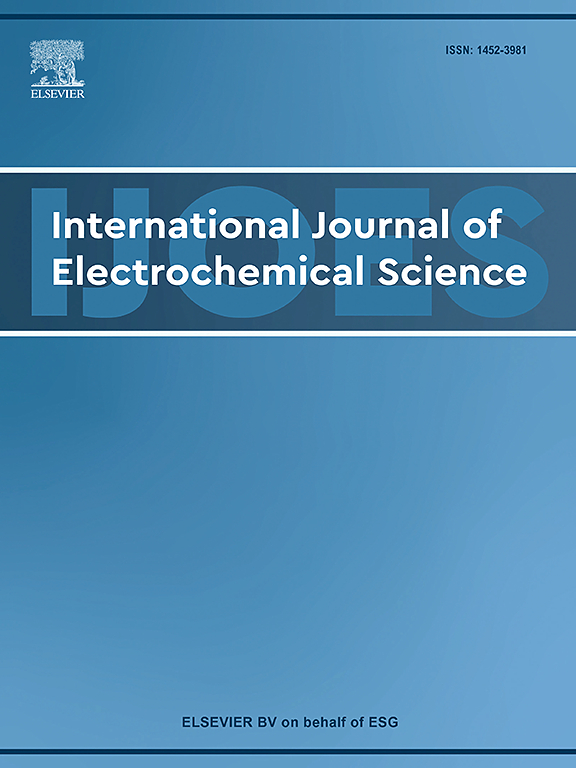Comparison of battery internal temperature using electrochemical impedance spectroscopy
IF 2.4
4区 化学
Q4 ELECTROCHEMISTRY
International Journal of Electrochemical Science
Pub Date : 2025-05-14
DOI:10.1016/j.ijoes.2025.101070
引用次数: 0
Abstract
In a battery storage system, a reliable temperature monitoring mechanism to completely eliminate the occurrence of thermal runaway accidents is a primary concern. At present, temperature sensors are used to measure the battery surface temperature. However, since battery heat is generated by internal electrochemical reactions, measuring the battery surface temperature can result in significant difference and heat transfer delay. This discrepancy can result in delayed detection of over-temperature conditions, potentially leading to safety hazards or even fire. To address these issues, electrochemical impedance spectroscopy (EIS) has been used to estimate the battery internal temperature (BIT). In this paper, EIS-based BIT estimation methods are reviewed and classified into four methods based on the EIS parameters used: the magnitude of impedance (|Z|), the phase shift of impedance (θ), the real part of impedance (Re(Z)), and the imaginary part of impedance (Im(Z)). Guidelines for selecting the appropriate frequency for more accurate BIT estimation are provided. Furthermore, a deep neural network (DNN) was adapted to construct an EIS-based DNN (EIS-DNN) to improve BIT estimation accuracy. EIS measurements were conducted on 28 brand-new batteries at different BITs and states of charge (SoC). The experimental results indicate that the conventional |Z|-based, θ-based, Re(Z)-based, and Im(Z)-based BIT estimation methods are feasible, with average temperature estimation errors (TETavg) ranging from 1.04°C to 3.24°C. However, significant differences were observed in the maximum temperature estimation errors (TETmax). The Im(Z)-based method performed the best, with a TETmax of 3.42°C, whereas the Re(Z)-based method exhibited the worst performance, with a TETmax of 18.59°C. In contrast, the proposed EIS-DNN method achieved significantly improved accuracy, with a TETavg of approximately 0.112 °C and a TETmax of 0.98 °C. Compared to traditional methods, the TETmax is improved by 71.3 %, and the TETavg is improved by 89.2 %.
用电化学阻抗谱法比较电池内部温度
在电池储能系统中,建立可靠的温度监测机制以彻底消除热失控事故的发生是一个首要问题。目前,温度传感器主要用于测量电池表面温度。然而,由于电池热量是由内部电化学反应产生的,因此测量电池表面温度会产生明显的差异和传热延迟。这种差异可能导致对超温条件的延迟检测,从而可能导致安全隐患甚至火灾。为了解决这些问题,电化学阻抗谱(EIS)被用于估算电池内部温度(BIT)。本文综述了基于EIS的比特估计方法,并根据使用的EIS参数将其分为阻抗幅值(|Z|)、阻抗相移(θ)、阻抗实部(Re(Z))和阻抗虚部(Im(Z))四种方法。为更精确的比特估计选择合适的频率提供了指南。在此基础上,利用深度神经网络(DNN)构建基于ais的深度神经网络(EIS-DNN),提高比特估计精度。在不同的BITs和荷电状态(SoC)下,对28个全新电池进行了EIS测量。实验结果表明,基于|Z、θ、Re(Z)和Im(Z)的传统BIT估计方法是可行的,平均温度估计误差(TETavg)在1.04 ~ 3.24℃之间。然而,在最大温度估计误差(TETmax)上观察到显著差异。基于Im(Z)的方法表现最好,TETmax为3.42°C,而基于Re(Z)的方法表现最差,TETmax为18.59°C。相比之下,本文提出的EIS-DNN方法获得了显著提高的精度,TETavg约为0.112°C, TETmax为0.98°C。与传统方法相比,TETmax提高了71.3 %,TETavg提高了89.2% %。
本文章由计算机程序翻译,如有差异,请以英文原文为准。
求助全文
约1分钟内获得全文
求助全文
来源期刊
CiteScore
3.00
自引率
20.00%
发文量
714
审稿时长
2.6 months
期刊介绍:
International Journal of Electrochemical Science is a peer-reviewed, open access journal that publishes original research articles, short communications as well as review articles in all areas of electrochemistry: Scope - Theoretical and Computational Electrochemistry - Processes on Electrodes - Electroanalytical Chemistry and Sensor Science - Corrosion - Electrochemical Energy Conversion and Storage - Electrochemical Engineering - Coatings - Electrochemical Synthesis - Bioelectrochemistry - Molecular Electrochemistry

 求助内容:
求助内容: 应助结果提醒方式:
应助结果提醒方式:


